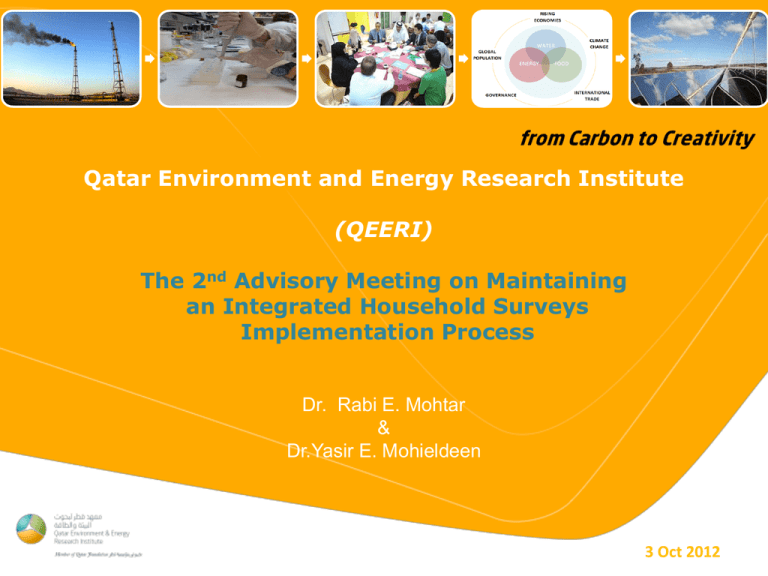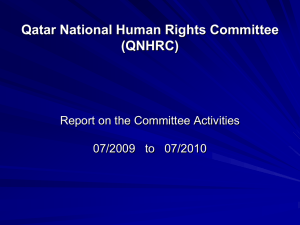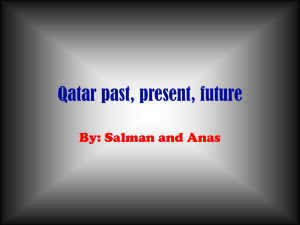QEERI - Ministry of Development Planning and Statistics
advertisement

Qatar Environment and Energy Research Institute (QEERI) The 2nd Advisory Meeting on Maintaining an Integrated Household Surveys Implementation Process Dr. Rabi E. Mohtar & Dr.Yasir E. Mohieldeen 3 Oct 2012 Structure: - Introduction to QEERI QEERI’s work Data requirement Data issues to be explored QEERI Vision To ensure sustainable development and management of Qatar’s energy and natural resources, preserving the quality of life of future generations and making Qatar a leader in cutting- edge energy and environment research QEERI Mission To conduct and coordinate multidisciplinary research that will address critical national priorities in energy and the environment, by integrating knowledge of the environment, food, energy and water resources in ways appropriate for Qatar and the region. Strategic Plan Overview (2012-2016) QEERI Projects 1) Air Quality modeling: - With collaboration with the Ministry of Environment, The Supreme Council of Health (SCH), Total & The Ministry of Energy/QP. - Objective is to map and model spatial distribution of pollutants in Qatar. - Will provide real time maps monitoring air quality. - Currently a pilot project focusing on area in Doha- 20km centered at QF. 2) Solar Atlas PI: Chmeissani, Darwish & El Gendy. - Assess and map solar energy potentials in Qatar. - Satellite imagery and ground measurements of solar radiation will be used: Optical Thickness/depth, LIDAR. - Modeling and interpolations techniques will be applied. Why Solar Energy? - Natural Gas and oil are finite and consumptions are excessively on rise. - Cost - This elongates the life of oil and natural gas resources, - Keep the return income from their export - Limits the emissions of Greenhouse Gases & air polluting gases 3) Soil & Water modeling (multi-scale hydrological modeling) PI: E. Braudeau Soil is « present » at all organizational levels of the agro- eco-systems Geomorphological, GLOBAL landscape …, SCALE (Earth systems) mapping units MACRO SCALE (soil mapping) Agronomical, pedological Mapping units HUMAN SCALE (soil surface) PEDON et soil surface MICRO SCALE (Soil medium) HYDRO-PEDOSTRUCTURE et BIO Studies of processes in the organized soil medium ___________________________________________________________________________________________________________ www.biologie.ens.fr/bioemco Challenge: coupling soil bio-geo-chemical and physical models with the organized soil system Three fundamental questions: 1. What is the appropriate soil typology to be used in representing the system? 2. What soil hydro-structural properties to be used (characterization)? 3. What is the thermodynamics of this system including the living organisms? The pedon, Representative Elementary Volume of a soil mapping unit Many processes in soil - Organic Mater mineralization - Roots dynamic and growing - Microbiology life - N and C cycles - Pesticides transfer, accumulation etc. - Plants feeding Soil is a physical organized medium allowing for life. It interacts with water and air that surround the solid phase of the soil structure. Spatial modeling of the bio-soil activity using soil mapping 4) Biodiversity: PI: Dr. Aurora Castilla Mapping of specific terrestrial plant and animal species in Qatar: - Inventory surveys - GPS registration of species locations - Habitat Suitability Analysis Data Source: Ministry of Environment 4) Biodiversity… cont Habitat Suitability Analysis modelling using GIS: Thank You Other layers will be included: climate, vegetation, ..etc 5) Water Quality PI: Dr. Shomar • Understanding the groundwater aquifer system in Qatar • Identification the environmentally hotspots affecting groundwater quality • Establishment of groundwater monitoring strategy, assessment and interpretation • Mapping of groundwater quality in Qatar using GIS and RS • Assessment of intrinsic vulnerability to contamination for Qatar aquifer using Integrated GIS and Earth Observation (EO) systems • Use the results of the study in supporting policy and decision making on water laws, acts, planning and management 6) Soil Quality PI: Dr. Shomar • Investigate the geochemistry of the topsoil in Qatar. • Identify the major natural and anthropogenic inputs affecting soil quality. Extract the spatial patterns of these inputs using GIS and RS, field observations and laboratory analyses. • • Provide sophisticated querying and visualization tools at national scale. • Produced maps to develop and design priority soil management/land use planning specifying the particular remedial measures that have to be applied on a preventive, protective and restorative basis. • Develop a platform for the EIA of the activities above the ground (industry, agriculture, tourism etc.) on the soil quality. • Use the results of the study in supporting policy and decision making on soil related issues, planning and management. Other studies - Dust storms modeling Ecological mapping Outreach and sustainability Marine biodiversity Energy Footprint CO2 Water, Energy and Food Nexus (WEF) Heat wave modeling in Qatar Heat Wave modelling 2 years HWI projection Data requirement • Base maps: International & administrative boundaries; roads, cities, villages, topography, …etc. • Population census data • Agriculture & Livestock: Production and export/import: livestock, food, ..etc • Agricultural input: fertilizers (types & amount), water, energy • Meteorology: temperature, rainfall, humidity, wind speed/direction, solar radiation, …etc. • Air quality data • Soil data and maps • Geology & Lithology Data requirement …con • Groundwater and wells: aquifers, locations, discharge, water chemical and physical properties. • Mangroves and Protected Area • Utilities : water network, electricity & Qtel. • Landuse • Vegetation cover/map • Water treatment plants: location, production, …etc. • Environmental hot-spots • Environmental Health: air/water/food borne diseases • Energy and water consumption • Awareness & conservation Data requirement …con • • Urbanization: projected plan. Energy : Sources and usage • Data request for WEF project 1. List of food products consumed in Qatar 2. Total Domestic production (ton) per food product [Total domestic production under open agriculture (ton) and total domestic under protected conditions (ton), per product] 3. Imports (ton) per food product 4. Countries of import and respective amounts (ton) per food product 5. Land requirements – for open and protected (ton/ha), per food product 6. Market price of domestic products (QAR/ton), per product 7. Market price of imported products (QAR/ton), per product 8. Fertilizer requirements per food products grown locally? (kg NPK/ton, other ?)… 9. Water requirements per food product grown locally (m3/ton) under open and protected agriculture 10. Projections for population (10 year-20year) 11. Projections for food prices (10 year-20year) Data requirement …con • Data request for the CO2 emission - houses by type (villas, apartments: small, medium, large) - cars (numbers and types) households expenditures on fuel, electricity, water. number of air conditions by house type. CO2 emissions Data Issues to be Explored 1) Data Quality measures 2) Data Quality and assurance measure and mechanism 3) Meta-data : data about the data 4) Follow international standards for data classification: LCC, OGC, FAO soil classification, USGS soil, EPA,… etc Example of bad practices: - Farms and settlements are used as classes in the Soil map of Qatar. - Landuse classes don’t follow LCC standards. - No meta-data describing the data, the date of collection, errors, method of collection,..etc.








